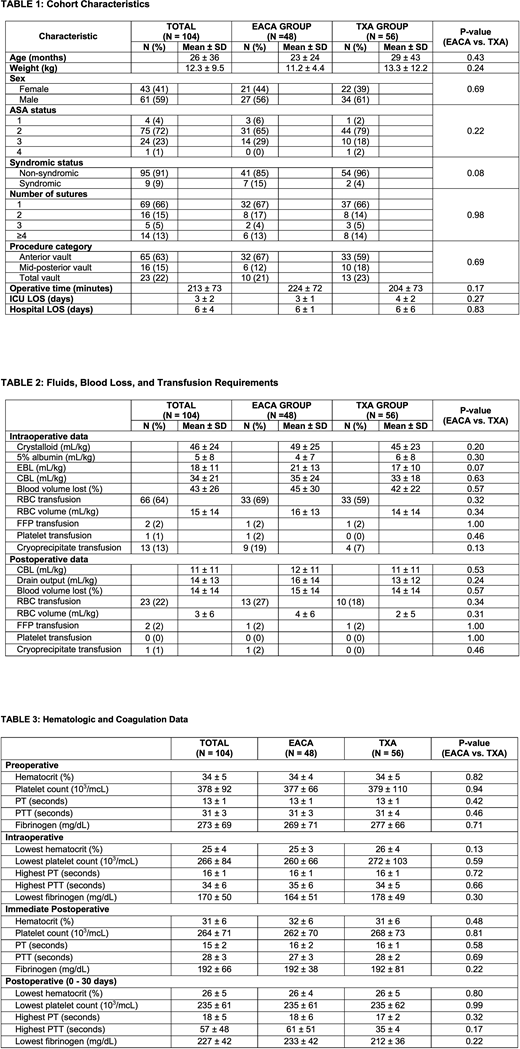Background: Children undergoing complex cranial vault reconstruction (CCVR) for craniosynostosis experience high rates of bleeding and blood product transfusion, increasing the risk of perioperative complications. The most severe issues relate to the rate and extent of blood loss, which can be up to several times the patient's total blood volume and is often equated to controlled massive hemorrhage. ε-Aminocaproic acid (EACA) and tranexamic acid (TXA) are antifibrinolytic agents that have been shown to reduce intraoperative hemorrhage and transfusion requirements during CCVR. However, the relative efficacy of EACA vs. TXA in CCVR has not yet been evaluated. The aim of this study was to compare perioperative blood loss and need for transfusion in children receiving EACA and TXA. We hypothesized that TXA is associated with a greater decrease in blood loss and transfusion requirements when compared to EACA.
Methods: All patients who underwent CCVR from September 2015 to December 2019 at our institution were retrospectively evaluated. The primary outcome measures included intraoperative estimated blood loss (EBL), red blood cell (RBC) transfusion volume (mL/kg), and calculated blood loss (CBL) (Kearney et al., Can J Anaesth 1989). Secondary outcome measures included hematologic and coagulation parameters. Study cohort demographic and outcome data were analyzed; Fisher's exact test was used for categorical data, student's t-test was used for continuous data. A p-value of < 0.05 was considered statistically significant.
Results: 104 patients were included in the study with 48 patients in the EACA cohort and 56 patients in the TXA cohort. There were slightly more patients with syndromic craniosynostosis in the EACA group, but overall no significant differences in cohort characteristics (Table 1). Mean EBL (mL/kg) was slightly higher in the EACA group vs. the TXA group (21 ± 13 vs. 17 ± 10), but not statistically significant. Intraoperative mean CBL (34 ± 21mL/kg) and intraoperative percent blood volume lost (43 ± 26%) for the cohort were high, but these were equal between groups. Likewise, postoperative DO, CBL and percent blood volume lost were similar between groups. Overall, intraoperative RBC transfusion was required in 66 (64%) of patients and was similar between groups (69% of EACA patients vs. 59% of TXA patients). Intraoperative transfusion of other products was equal between groups. Postoperatively, 23 (22%) of patients required RBC transfusion. Postoperative blood product transfusions were equal between groups (Table 2). We compared routine hematologic and coagulation parameters peri-operatively and did not find any differences between the EACA and TXA group (Table 3). In the EACA group, there were 6 reported perioperative complications, including 2 suspected seizure events, as compared to 7 complications in the TXA group, which included 2 thromboembolic events.
Discussion: Pediatric CCVR is a high blood loss surgery and this can lead to a consumptive coagulopathy for which intraoperative antifibrinolytic agents have been demonstrated to improve outcomes. We found no significant difference in blood loss, transfusion requirements, or hematologic parameters between patients who received EACA and TXA in our retrospective pediatric CCVR cohort. Overall there were 4 postoperative outcomes that could have been related to antifibrinolytic use (seizure, thromboembolism), but this was equal between groups and causality was not confirmed. Further research is needed to define optimal antifibrinolytic dosing and duration of therapy. While standard hematologic and coagulation parameters were similar between groups, the mechanisms of surgically induced coagulopathy in CCVR still need to be explored. Future studies investigating coagulation-based and inflammatory assays may be useful in defining surgical-induced coagulopathy.
No relevant conflicts of interest to declare.
Author notes
Asterisk with author names denotes non-ASH members.


This feature is available to Subscribers Only
Sign In or Create an Account Close Modal